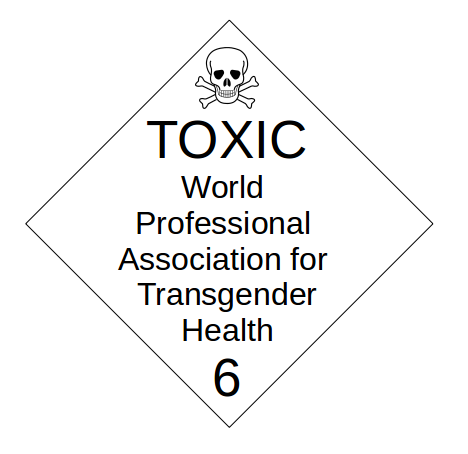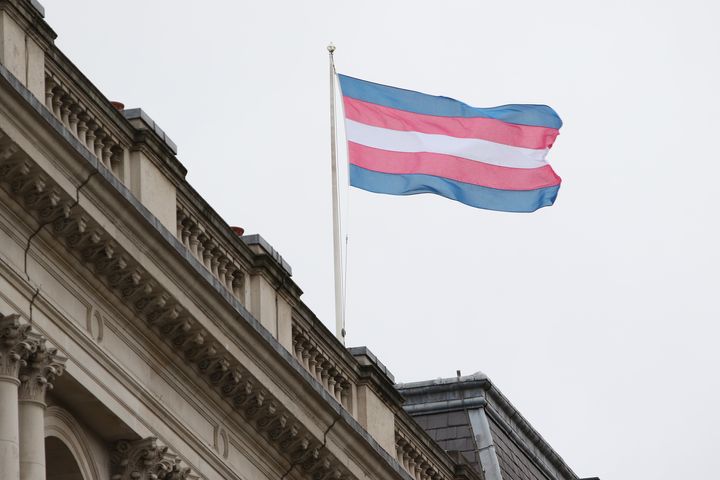Refugees From Reality: Religious Trauma and Gender Identity
Patriarchal religions as a funnel to transgenderism.

Transgender identities are on the rise in the United States and across the world. Between 2011 and 2016, the rate of trans-identifying people in the United States doubled to 1.4 million, an unprecedented jump. While most trans people are attempting to transition to the opposite sex, other trans identities are also on the rise, with some gender clinics reporting a growing number of patients identifying as “non-binary,” a term meaning neither male nor female.
Some attribute the rise in trans identities to growing awareness, others to social contagion. It seems there are a variety of social, political, and economic forces at play pushing this growth — and while it’s unclear whether trans people themselves are actually benefiting from this paradigm shift, it is clear that many people see transition as a way to improve their current situation. Yet, little work seems to have been done to examine what exactly trans-identifying people are running from and why transition, which involves drastic social upheaval, possible discrimination, and lifelong medical complications seems like a reasonable solution.
For many, the answer may lie in religion. Patriarchal religions have traumatized generations of individuals who do not conform to expected sex-role stereotypes, trained them in magical thinking, and pushed those excluded into finding a new religion in which they are able to relive these traumatic patterns: the religion of Gender.
Religion, Sexuality, Trauma, and Abuse
Patriarchal religions (like Christianity, Judaism, and Islam) push regressive gender roles in which men and women have clearly defined roles, often with the woman in a subordinate position. These religions (or at least their followers) are often hostile to homosexuality, gender non-conformity, and women’s liberation. In her 2018 article, "Gender Colonialism," Jewish artist Nina Paley discusses how the transsexuals of the 1990s were “refugees” from masculinity. These were men who did not conform to traditional gender roles and sought an alternative. Women saw a kinship in these refugees from the patriarchy and were willing to take them in. Today, women, especially lesbians, are finding themselves in the same position — seeking refuge from the religious repression they grew up with.
Take, for example, Gavin Grimm — a female who grew up under an oppressive religious family where girls and boys were treated according to strict gender roles. After leaving Christianity, Grimm came out as trans, and now identifies as a man:
“As I grew up in my Southern Baptist household with parents who unwittingly held just about every prejudice imaginable, I realized quickly that there were several aspects of the life that I was born into that I did not actually subscribe to.
For example, at the tender age of eight my parents told me I could no longer walk about four hundred feet to my friend’s house because he was a boy, but my brother could. I was hurt because this neighbor boy was my friend, and I was also struck by the unfairness of it. Alongside that feeling, there was something else. Something I didn’t know how to vocalize any other way than 'I’m no different from my brother.'
They thought I was a budding feminist, demanding equal rights on the playground. (Which itself was a concept most people in my life thought fit to ridicule rather than celebrate.) My voice was drowned out by the noise of a culture not built to recognize a transgender child.”
Grimm is not the only lesbian (female homosexual) to experience the trauma of patriarchal religion. A 2008 study identified Judeo-Christian religions as a tool of “social injustice” against lesbians, and about 40% of trans-identifying individuals who participated in a faith-based community report leaving it due to fear of being rejected. People from racial and ethnic minorities which are known to be more hostile towards homosexuality and gender non-conformity are also more likely to identify as transgender, and trans-identification is more common among conservatives than liberals — pointing to a greater need to escape oppressive gender roles for both men and women in places where the pressure to conform is the strongest.
Every single trans-identifying female I know comes from an oppressively religious past. My sisters and I grew up in a church where our youth pastor proclaimed that Hurricane Katrina was the result of the rise of gays in America and that God was punishing us — like in Sodom and Gomorrah. I was 13 at the time I heard this statement, and had already started to form some of my own opinions on the church. My younger sister, however, was eight years old. What impact does hearing this have on a young girl who has still not come to terms with her homosexuality? For some young gays and lesbians, this sort of language in the church may even be traumatic, amounting to psychological abuse which will shape their perception of themselves and their sexuality well into adulthood. My sister, who heard these messages about people like her all throughout her childhood, came out as trans in high school.
In some countries, the connection between homosexuality and religious refugees to transgenderism is even more clear. In Iran, the theocracy punishes homosexuality by death — yet the government itself offers grants to pay for sexual reassignment surgery of up to $12,000. It’s no surprise, that under such extreme conditions, some homosexuals are choosing to undergo sexual reassignment in order to live “openly,” as was revealed by a 2016 Huffington Post investigation. Trans-ing the gay away has become a liberally accepted form of conversion therapy for those living under oppressive religions, either home or abroad.
For some trans people, the trauma they are fleeing is more than emotional. According to the 2015 National Trans Equality Survey, nearly half of trans-identifying people report experiencing sexual assault or abuse in their past, with rates being highest among biological females, regardless of identity. Over a quarter of those victimized report experiencing abuse by a relative or teacher. The rate is even higher among teens who experience “Rapid Onset Gender Dysphoria,” who are primarily female.
The stories of individuals who experienced child sexual abuse and later regret transition are starting to become more and more common. Walt Heyer, who experienced this himself, tells the story of Billy. While growing up gender non-conforming in a religious family, Billy experienced child sexual abuse, and later transitioned as a way to escape his pain:
“Billy longed to escape from his skinny body and speech difficulty. In his nightly bedtime prayers, he begged God to change him into a girl so that the other kids wouldn’t make fun of him. …
At summer swimming league, Billy’s new diving instructor targeted Billy for sexual abuse — abusers have a knack for picking on the weakest kids. Billy says, “The coach played with me.” …He says that after the sexual abuse “I so very much hated my appendage” — that is, his male genitalia.”
Billy later returned to the Church and de-transitioned (reversed his transition and went back to living as a man), a phenomenon that is increasing despite being swept under the rug in the mainstream trans narrative. In a non-random survey of de-trans females on Tumblr, multiple users cited their trauma, and subsequently getting help for that trauma, as reasons for their transition and de-transition relatively:
“Nothing has helped as much as getting mental help for trauma and building a healthier life where I can accept myself and the reality I live in.”
“Not thinking about my dysphoric feelings did more to resolve them than anything else — addressing the sexual trauma that fueled them, leaving the house, leaving tumblr, and building a self identity based on my hobbies and abilities.”
Religion, Magical Thinking, and OCD
A 2013 study published in Cognitive Science demonstrated that children with religious learning (either in school or at home), were less likely to accurately separate reality from fiction when asked to categorize stories containing magical or impossible elements, stating:
“The presence versus absence of a religious education is associated with children’s conviction that ordinarily impossible events can or cannot occur in a realistic story.”
While this study was conducted on Kindergartners, other studies have demonstrated that magical thinking does not decline with age as might be expected. In fact, rates of magical thinking at the ages of 16 and 17 appear no different than that of 5 and 6-year-olds. Children who have their ability to distinguish fact from fiction hampered by a religious upbringing go on to become teenagers and adults who continue to display patterns of magical thinking. Some social workers, who focus on transgender youth, even report this phenomenon, such as the Social Work Practice with Transgender and Gender Variant Youth 2009 report which stated:
“As a means of coping with the daily stress of living in a hostile environment, many FTMs reported engaging in magical thinking and daydreaming…”
This is not a surprise since transgender ideology itself relies on magical thinking: the idea that one can be “born into the wrong body.” Accepting that someone is born into the wrong body requires a non-scientific understanding of consciousness. Rather than understanding consciousness as a property arising from our physical, material, brains with their neurons and synapses, in order to be born into a body you must have consciousness outside of that body in the first place. This hearkens back to the religious idea of a soul — an extra-physical consciousness belonging to a person, where the body is the mere vessel for the consciousness rather than the source of the consciousness itself. This theme of being trapped in the wrong body is a common thread throughout trans narratives and relies on a deeply religious understanding of self that lacks any scientific backing.
D’avid Middle-Ground, a biological female, writes about experiencing distress upon realizing that they were “born into the wrong body”:
“As I sat on that tricycle, all of this reality flooded over me. Feelings of despair filled my soul. I knew that my life was permanently out of my control. I was stuck in this thing that was not mine. My body would not allow me to be the genuine person that I was. I was born into the wrong body and that would never change.”
D’avid is not alone in this struggle. This is a narrative that is repeated ad nauseam in the trans community. Gabrielle Ludwig shared his struggle with The Week, stating:
“Every day I was reminded that I couldn’t be myself. You look in the mirror and you see something where your body does not match your spirit. That’s an inexpressible degree of private grief.”
These stories are shared not to make light of the very real psychological pain that these individuals have experienced. Body Dysmorphia Disorder has long been recognized as a psychological disorder, which the DSM-5 classifies under “Obsessive-Compulsive and Related Disorders.” Those with mental illness deserve dignity, access to health care, and compassion. However, the medical community has by-and-large decided to “affirm” the magical delusion of a gendered spirit in favor of actually treating the underlying mental illness present.
The fact that Body Dysmorphia Disorder is classified under the OCD family is not a surprise. This disorder involves obsessive thoughts about the “wrongness” of one’s body, and compulsive behaviors to address it, such as attempting to alter your body, seeking validation from others, and even changing clothes.
The same study which demonstrated that children retain their tendency towards magical thinking as they get older also demonstrated a link between magical thinking and OCD. Other researchers have also pointed out connections between trans-identification and OCD, at least in some patients. More recently, those in the OCD advocacy community have been faced with a slew of challenges related to the rise of trans-presenting OCD. In 2017, Jemima Sonorryan, OCD awareness advocate, wrote a detailed analysis of how she perceived the rise of trans-themed OCD (TOCD). She discusses the cultural impact on OCD themes, such as the increase of religious-themed OCD in ultra-orthodox Jewish communities and in highly religious Middle Eastern communities. She writes:
“The ‘hot topics’ of the culture around an OCD sufferer seem to influence their OCD themes. It’s no surprise, therefore, that as trans visibility in the media increases, OCD themes have been changing along with it… OCD obsessions about your sexuality are perfectly possible. It’s a small jump for the OCD mind to make, then, to start obsessing about the ‘T’ instead of the ‘LGB’.”
The connections between religious upbringing, magical thinking, OCD, and body dysmorphia paint a picture of a group of people who have been let down by their families, churches, and medical institutions alike. By focusing on providing “affirmative” care for a spiritual delusion rather than healing care (as we do for every other psychological disorder, including other forms of body dysmorphia), practitioners are only hurting these people more — and breaking nearly every medical oath in the process. More and more pressure is being put on doctors to conform to the new trans narrative as the gospel spreads, and everyone is afraid to be on the “wrong side of history.”
Gender: The New Religion
A 1989 study published in The Psychiatric Clinics of North America demonstrated that while people ordinarily choose to avoid pain, under stressful circumstances, people will return to familiar behavior — whether it is advantageous or not. For people who have experienced trauma, this can mean returning to their earlier behavior patterns present during the traumatic experience. Trauma reenactment is common, and people with many forms of trauma may experience it to some degree. For some, this may look like repeatedly entering unhealthy, and even abusive, romantic relationships which replicate the experiences of abuse or neglect in their childhood.
For those with religious trauma, the desire to re-live their religious experience in a new form may be tied to this known behavioral pattern. Those who have left their previous religion due to rejection or fear but maintain a level of religious seekership, or the desire to find spiritual enlightenment and openness to new ideas, are particularly at risk of recruitment to cults.
Modern gender ideology displays multiple similarities to religion, and in some cases even cults, attracting those who are refugees from religion due to their sexuality or gender non-conformity —girls and young women are especially vulnerable. The similarities with religion don’t end at magical thinking and science-denial, though. Gender acolytes practice their religion with many of the same social patterns of both the mainstream religious and religious extremists.
One relatively harmless parallel between the Religion of Gender and other religions is the choosing of a new name, and the desire to be “born again.” In Christianity, new believers are considered “born again” when they take a public oath accepting Jesus Christ as their Lord and savior, dedicating their life to Him. In Catholicism, the practice of “confirmation” even involves the choosing of a new name for oneself, often a saint or virtue which the believer feels represents their personality or goals. The Confirmation is meant to take place when the individual is old enough to choose to believe for themselves rather than at the will of the parents, and choosing their own name reflects this newfound self-hood. Similarly, trans-identification often comes with a declaration of their name change, and a similar sentiment of being “born again” (even referring to their birth name as a “dead name”). In a Popsugar article from 2018 on dead-naming, author Ryan Roschke wrote:
“Most of the time, an individual will pick a new name as soon as they begin to identify as the gender they know they are on the inside. This new name, in a way, marks the “death” of their old identity and the person they once were. With a new name, they signify a new, more truthful, and more fully realized phase of their life.”
While name-choosing is fairly trivial and usually hurts no one, other aspects of the Religion of Gender cause serious harm. The cult-like mentality which has been built around gender affirmation is playing out like a viral witch-hunt in front of our eyes. Like Jehovah’s Witnesses who are expected to shun a family member gone astray, modern academics, non-profit providers, techies, and activists are all expected to shun Gender Heretics. Jehovah’s Witnesses live in constant fear of disfellowship. Likewise, women in the public sector especially are living in fear should they be exposed as Gender Heretics and “disfellowshiped.”
Some have decided to take their religion to even greater extremes and are waging a Gender Jihad, threatening to rape, kill, and maim anyone who does not subscribe to their religious, magical thinking. This sort of call to violence against entire groups of people based solely on ideology or belief (rather than say, race or country of origin) is rare outside religion. This behavior in the trans-activist community must be treated as religious extremism and taken seriously.
Conclusion
While no two trans-identified people share the exact same story of how they came to be trans, the pattern of religious trauma, magical thinking, and reenactment in those experiencing sex-related body dysmorphia needs to be taken seriously if we ever wish to address the harms of this epidemic on individuals both inside and outside of the trans community.
As someone who personally grew up in this sort of environment and struggled with my own sexuality accordingly, I empathize with those who seek refuge away from the abuses of the church. Yet, continuing patterns of delusional and magical thinking is not a real refuge — it is a temporary coping mechanism. Psychologists and medical doctors alike have an obligation to stand firm against pressure and push for those with mental illness to get the actual help and treatment they deserve, whether that’s for PTSD and other trauma-related disorders, OCD, or body dysmorphia.
It is possible to be both compassionate towards trans-identifying people, and to recognize the harms that come with the ideology — just like it is possible to be compassionate towards religious individuals and yet critique the harms of patriarchal religions on women and gender non-conforming people. Despite claims to the contrary, to criticize an ideology is not to deny anyone’s humanity. Rather, it is to recognize that because of the inherent worth of every individual, trans people deserve more than they are getting. Refugees from a cruel, painful, and unfair reality deserve to find peace, and love, and comfort. Our goal should not be to affirm the denial of reality in favor of magical thinking, but rather to seek to build a reality for all people that needs no refuge in the first place.
The generous support of our readers allows 4W to pay our all-female staff and over 50 writers across the globe for original articles and reporting you can’t find anywhere else. Like our work? Become a monthly donor!
Enter your email below to sign in or become a 4W member and join the conversation.
(Already did this? Try refreshing the page!)




Comments